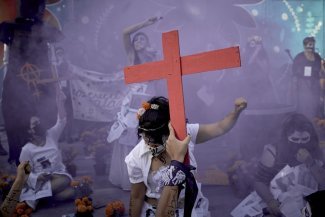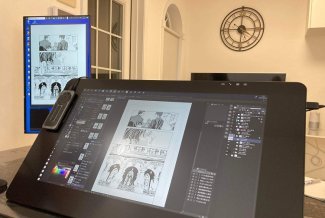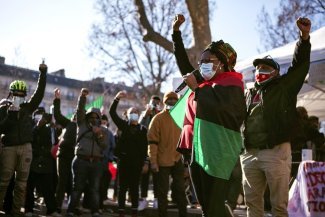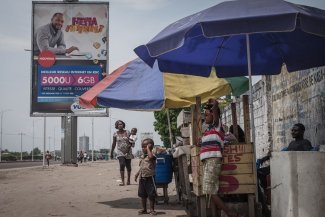
In the wake of a bomb attack on a train at Parson’s Green station in London in September, right-wing Brexit advocate and Trump supporter Nigel Farage led the calls for British police to be armed. Currently, guns are restricted to specialist firearms units, like the one that halted the London Bridge terror attack in June after just eight minutes.
The UK has long been proud of this model of policing by consent, but the consensus is beginning to fray. In a recent poll, a third of officers supported the idea of routinely being armed, compared to 23 per cent in 2006.
It’s understandable, but seductively simplistic. One lesson from America - where heavily armed police were unable to stop the 307th mass shooting this year from taking place in Sutherland Springs, Texas last month - is that more guns will not prevent attacks. Any discussion of UK police resources must take account of public service cuts which are putting police forces under strain.
Another factor that must be accounted for is the possible effect on black Britons, particularly black men, who are disproportionately represented in the criminal justice system. While more guns may not stem terrorist attacks, they may well lead to a rise in deaths at the hands of the police.
According to Inquest, the charity that supports the families of those who have died in state detention, 14 per cent of those who have died either in police custody or following contact with the police in England and Wales since 1990 are black and minority ethnic (BAME).
Unlike the US, where black people are more likely to be killed by police than any other group, BAME Britons are not dying disproportionately, although a government-commissioned review into deaths in police custody recently acknowledged that racial discrimination may be a “significant contributory factor” in such fatal incidents.
The report by Dame Elish Angiolini was finally released in October after a 15-month delay and makes 110 recommendations, including reforms to the Independent Police Complaints Commissions (IPCC), where former police officers currently lead the investigations.
It also highlighted that race is not routinely considered as a factor in IPCC investigations despite the fact that black people are over-represented in deaths occurring following the use of police force and restraint methods. At the time of writing, 15 year-old Terrell DeCosta Jones-Burton is seriously injured in hospital after he was slammed off his bike during a police stop as he cycled near his home in South London.
Every death at the hands of police bears troubling hallmarks that fuel mistrust between these communities and the police – and will not be improved by having more armed police on the streets. In 2011, for example, riots erupted across the UK following the fatal police shooting of Mark Duggan.
And this September, the Observer newspaper published eyewitness reports in the cases of four black men who died following police contact between June and July this year. Each case involves allegations of disproportionate police conduct, reports of the men becoming ‘unwell’, dying - and, to the anguish of their families - no police officers suspended while the police watchdog investigates. To date, despite over 1,000 deaths since 1990, no officer has been successfully prosecuted for a death in custody.
Black Lives Matter worldwide
The reason the Black Lives Matter movement, which started in the US in protest at the disproportionate deaths of African-Americans at the hands of police, has resonated worldwide, including Europe, is because Black people in the diaspora often experience institutional racism which puts their lives at risk.
Black Lives Matter protesters took to the streets in France following the death in police custody of a young black man, Adama Traoré, in Beaumont-sur-Oise in 2016. The police said that he died of a heart attack but his family claim that he was beaten to death by officers. So do the family of Mitch Henriquez, who died in police custody in the Netherlands in June 2015 after he was ‘taken ill’ on the way to a police station. The language of Black Lives Matter is a helpful shorthand to draw attention to these cases, but while the movement is relatively new, this issue is not.
In Germany in 2005, Oury Jalloh from Sierra Leone was detained by police, who chained him by his wrists and ankles to the floor of a holding cell. He later burned to death on a fireproof mattress. This February, following a visit to Germany, the Working Group for the UN Decade of People of African Descent issued a statement that quoted Jalloh’s case and many others, citing “institutional racism and racist stereotyping by the criminal justice system” as a reason for “the failure to effectively investigate and provide justice in cases of racial discrimination and violence against people of African descent by the state, in particular by the police.”
Institutional racism is one reason why campaigners in the UK have branded BAME deaths in custody a challenge to the UK criminal justice system as profound as that of Stephen Lawrence, whose murder by racist youths in London in 1993 sparked an inquiry into institutional racism in the Metropolitan Police. The situation has improved, but not fast enough.
Last month, the UK government launched a dedicated website and audit into racial disparity across the country, which revealed entrenched institutional racism. Much of the data is not new, but the site makes it more easily available. As revealed earlier this year in a landmark review of the justice system conducted by the Labour MP David Lammy, young black men are disproportionately represented at every stage of the justice system.
The audit should be used to inform policy, yet the discussion on arming the police does not take these statistics into account, even though black people are more likely to be perceived as dangerous and this influences the institutional response.
A black man in the UK is 17 times more likely than a white man to be diagnosed with a serious mental health condition such as schizophrenia or bipolar disorder, and black people are also four times more likely to be sectioned under the Mental Health Act. Mental health services often intersect with the criminal justice system.
When Sarah Reed died in Holloway Prison in 2016, she was already well-known to campaigners as the victim of a police assault in 2012, which exacerbated her existing mental health difficulties. She was awaiting assessment in prison to see if she was mentally fit to plead after being charged with assaulting a nurse in a secure psychiatric unit.
The jury at the inquest into her death found that unacceptable delays in psychiatric assessment and failures in care contributed to her death. They also raised concerns that Reed did not receive adequate treatment for her high levels of distress. Instead, Reed was treated as a threat while her condition deteriorated. Her mother told the BBC of the family’s distress upon learning that prison authorities denied Reed opportunities to bathe, or food and water “because they felt she was in such a psychotic state that she couldn’t be approached,” and called for mental health assessments to take place in hospitals, rather than prisons. Inquest’s research indicates that the proportion of BAME deaths in custody where mental health-related issues are a feature is nearly two times greater than it is in other deaths in custody.
Arming the police will not make Britain safer, but could exacerbate existing inequalities in the justice system and increase the risk of further black deaths in custody. The lesson from the US and Europe is that institutional racism costs lives. The UK is no exception.








